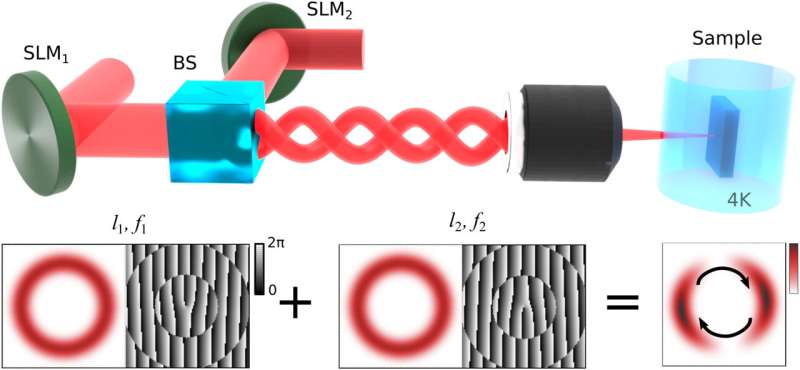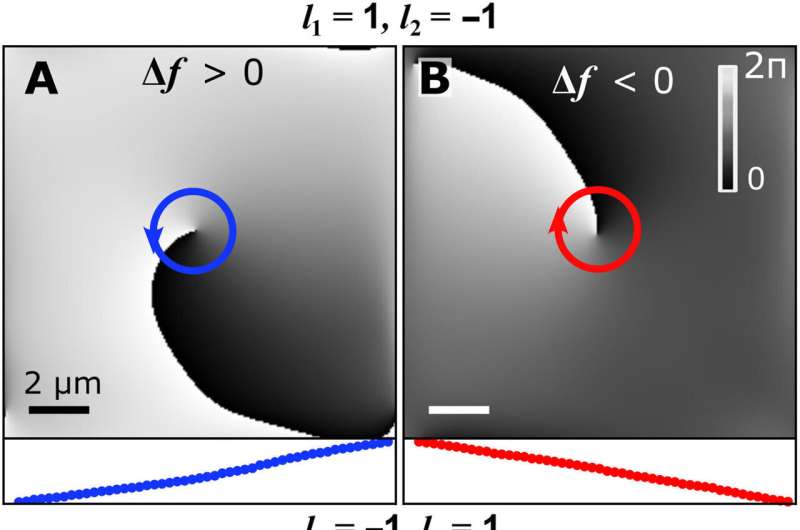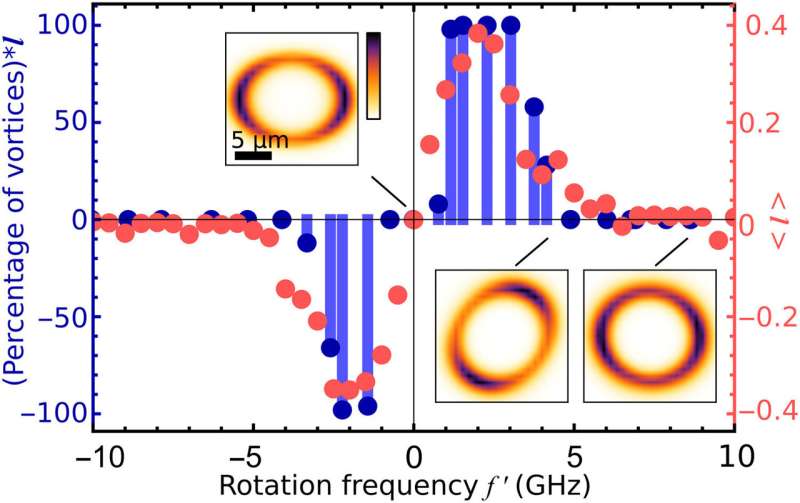The pumping configuration in the rotating bucket experiment with polaritons. The top part depicts the optical excitation path of the two frequency-detuned, f1 − f2 ≠ 0, spatially modulated, single-mode lasers. The bottom part illustrates the spatial intensity profile (in red color) of the two lasers that are individually shaped, with two phase-only spatial light modulators (SLMs), to form ring-like intensity profiles of opposite optical angular momentum l1,2. The composite excitation beam acts as a rotating dumbbell-shaped polariton trap that both injects and stirs the forming polariton condensate, similar to the optical ferris wheel for ultracold atoms. The grayscale images are the corresponding "perfect" vortex phase masks applied on the SLMs. Credit: Science Advances (2023). DOI: 10.1126/sciadv.add1299
Quantized vortices can be generated in classical experiments of liquid helium and ultracold dilute gases to conduct fundamental and comparative studies of different superfluids. In a new report published in Science Advances, Ivan Gnusov and a research team in photonics and physics in the U.K., Russia and Iceland developed a "rotating bucket" experiment to optically contain the quantum fluid of light.
The experiments depended on exciton-polariton Bose-Einstein condensates within the semiconductor microcavity. The team used the beating note of two frequency stabilized single-mode lasers and generated an asymmetric time-periodic rotating non-resonant excitation profile. They then studied the dependence of the rotation frequency to reveal a range of stirring frequencies that favored quantized vortex formation. The outcomes can facilitate the study of polariton superfluidity to understand the role of optics on structured nonlinear light.
The 'rotating bucket' experiment
Orbital angular momentum (OAM) in optical vorticity is essential to encode and process optical information; the phenomenon has led to the development of microlasing devices. Optical vortices markedly differ from conventional vortices seen within interacting fluids. For instance, conventional vortices are abundantly found in nature, ranging from enormous vortex storms within the gas belts of Jupiter to the tiny micron-scale quantum vortices in macroscopic quantum systems such as superconductors, superfluids and Bose-Einstein condensates. While optical vortices are geometric in origin, the vortices in superfluids and Bose-Einstein condensates are thought of as topological defects.
Despite significant advances in the field of polaritonics, researchers have yet to understand vortex formation in a stirred polariton condensate or a "rotating bucket" experiment with liquid helium or diluted quantum gases. To generate the phenomenon, physicists used external electric fields or magnetic fields. In this work, Gnusov and colleagues shaped the rotating bucket experiment in a polariton condensate or bosonic quasiparticles that exist inside semiconductor microcavities by using a cylindrically asymmetric optical device. They then formed an excitation pattern by beating the note of two frequency detuned single-mode lasers of opposite orbital angular momentum to form a composite beam.
Quantized vortex formation in the rotating bucket experiment. (A) Real-space normalized photoluminescence intensity of a polariton condensate under a nonresonant, counterclockwise rotating excitation beam [Δf = 4.6 GHz, (l1, l2) = (1, − 1)]. The dashed line corresponds to the circumference of the effective optical trap. (B) Angularly resolved normalized photoluminescence intensity of the trapped condensate (false color in logarithmic scale). The white dashed curve depicts the lower polariton dispersion branch. (C) Interference pattern of the condensate emission with a resonant, plane-wave, reference laser, revealing a fork-like dislocation in the center of the condensate wave function (see magnified region of interest). (D) Phase distribution of the condensate wave function showing a counterclockwise winding phase singularity confirming the formation of a quantized vortex (in false gray scale). Credit: Science Advances (2023). DOI: 10.1126/sciadv.add1299
The pumping configuration in the rotating bucket experiment and numerical modeling
During the experiments, the team optically injected the polariton condensate into an inorganic microcavity containing Bragg reflectors with quantum wells embedded within the intracavity optical field. They then held the sample in a cold-finger cryostat at 4 K. Thereafter, the team superimposed two spatially modulated lasers on a non-polarizing beam-splitter to form a rotating dumbbell-shaped excitation pattern, where the direction and frequency of the rotation were derived from a preceding study.
For zero-frequency detuning between the two lasers, the team noted the formation of a static dumb-bell shaped hot exciton reservoir to partially contain polaritons within the excitation profile due to the repulsive interaction between excitons and polaritons. They quantitatively reproduced the results via numerical modeling by using a generalized 2D Gross-Pitaevskii equation. The competition between the gain and losses resulted in a quantum vortex that co-rotated with the exciton reservoir. Aside from the capacity to reproduce the formation of quantum vortices in rotating polariton fluids, the structured light sources with regulated charge offered applications in classical and quantum communications.
Deterministic control of the quantum vortex charge. Real-space phase distribution of the condensate wave function demonstrating corotation of the winding of the vortex phase with the excitation beam. (A and D) A counterclockwise and (B and C) a clockwise winding of the phase following the excitation beam. The winding of the phase is determined by controlling the OAM l1,2 and lasers frequency difference Δf. In (A) and (C), Δf = 4.6 GHz, and, in (B) and (D), Δf = − 3.7 GHz. The bottom inset of each panel (red/blue solid dots) show the nearly constant angular phase gradient around the line-profiles of the respective phase singularity. Credit: Science Advances (2023). DOI: 10.1126/sciadv.add1299
Frequency-dependent quantum vortex formation
Gnusov and colleagues were primarily interested in the dynamics of the rotating bucket experiment relative to its dependence on the corresponding frequency during quantum vortex formation. By tuning the rotation frequency of the excitation pattern with a diameter of 14 μm, the team observed quantum vortex formation between 1 and 4 GHz.
The scientists recorded the interface for each frequency and extracted the real-space phase distribution for 100 "single-shot" realizations. They then developed a vortex sorting algorithm to differentiate the quantum vortex states during the experiment. Yet again, the team integrated numerical simulations to quantitatively confirm the experimental observations and quantum vortices as a function of rotation frequency.
Rotation frequency dependence of a quantum vortex state formation. Histogram of realizations of quantum vortices for l1 = 1 and l2 = − 1. Blue markers show the product of the percentage of realizations wherein a quantum vortex occurs multiplied by the optical angular momentum of the resulting state at each rotation frequency f' . Red markers show the average angular momentum of the confined quantum vortex states obtained using a 2D generalized Gross-Pitaevskii theory. The insets depict snapshots of the exciton reservoir density distribution for 0-, 5-, and 10-GHz rotation frequencies. Credit: Science Advances (2023). DOI: 10.1126/sciadv.add1299
Outlook
In this way, Ivan Gnusov and colleagues studied quantum vortex formation in ultracold quantum gasses and liquid helium to understand the fascinating fundamental and comparative studies of superfluids. The team realized the formation of quantum vortex states in the lab via the rotating bucket experiment based on Bose-Einstein condensates of polaritons. The underlying physics of the polariton shifts required stirring frequencies in the gigahertz range.
Due to the existing capacity to rapidly create extended polariton networks, this method will enable researchers to engineer of vortex arrays and study the complex interplay of polarization, orbital angular momentum and linear momentum degrees of freedom in large-scale driven-dissipative quantum fluids. The experimental demonstrations provide a source of optical vortices to empower applications in classical and quantum computing with potential to examine the transport of quantum fluids.
More information: Ivan Gnusov et al, Quantum vortex formation in the "rotating bucket" experiment with polariton condensates, Science Advances (2023). DOI: 10.1126/sciadv.add1299
Johannes D. Plumhof et al, Room-temperature Bose–Einstein condensation of cavity exciton–polaritons in a polymer, Nature Materials (2013). DOI: 10.1038/nmat3825
Journal information: Nature Materials , Science Advances
© 2023 Science X Network

![Quantized vortex formation in the rotating bucket experiment. (A) Real-space normalized photoluminescence intensity of a polariton condensate under a nonresonant, counterclockwise rotating excitation beam [Δf = 4.6 GHz, (l1, l2) = (1, − 1)]. The dashed line corresponds to the circumference of the effective optical trap. (B) Angularly resolved normalized photoluminescence intensity of the trapped condensate (false color in logarithmic scale). The white dashed curve depicts the lower polariton dispersion branch. (C) Interference pattern of the condensate emission with a resonant, plane-wave, reference laser, revealing a fork-like dislocation in the center of the condensate wave function (see magnified region of interest). (D) Phase distribution of the condensate wave function showing a counterclockwise winding phase singularity confirming the formation of a quantized vortex (in false gray scale). Credit: Science Advances (2023). DOI: 10.1126/sciadv.add1299 Quantum vortex formation in the lab](https://scx1.b-cdn.net/csz/news/800a/2023/quantum-vortex-formati-1.jpg)

























